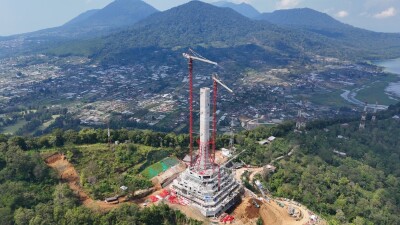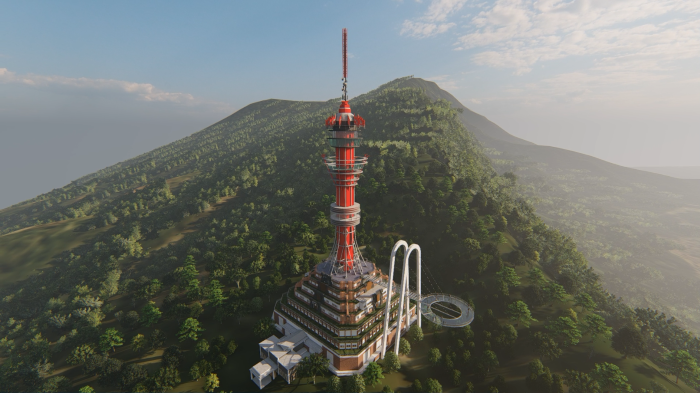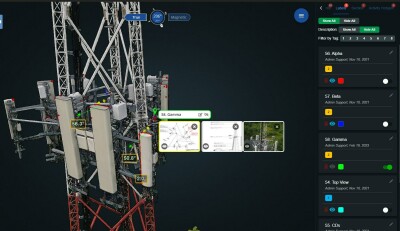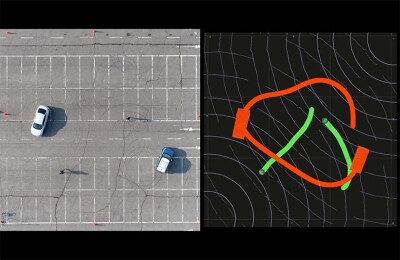Contributed by Marion Bouillin, Bentley Systems
As a tourist destination, the verdant island of Bali is Indonesia’s crown gem, with more than two million foreign travelers visiting in 2022. The island’s tourism is a significant national economic engine, contributing up to 40 percent of the foreign income funneled into Indonesia, according to the Bali Provincial Government.
In some areas, Bali is significantly developed, with luxury hotels lining the island’s southernmost shores. However, Bali’s northern reaches are quieter and less trafficked by tourists - as well as having limited access to internet and cell communications.
To boost tourism on the north side of the island, Bali’s government commissioned PT Hutama Karya (Persero), a state-owned contractor charged with promoting Indonesian infrastructure, to build a major telecommunications tower in Bali’s Buleleng district. The 142-meter Turyapada Tower, expected to be complete by the end of 2023, will provide cell signal across much of Bali, including the Jembrana and Karangasem districts, as well as Buleleng. The tower’s signal range will reach 4.6 square kilometers.
In addition to enabling cell communications, digital television broadcasts, and internet access, Turyapada Tower will be a new high-rise tourism destination. Its interior will include a planetarium, a skywalk, a rotating restaurant, and a convention space. A museum that showcases Balinese technology and culture from various historical eras will also be a partner.
Positioned prominently atop a hill at 1,562 meters above sea level, Hutama Karya believes that the Turyapada Tower’s visibility and striking design will make it an iconic, world-class tower, on the level of the Eiffel Tower, Tokyo Tower, or Macau Tower.
"Turyapada Tower, in our opinion, will be a new destination for tourism, creating job opportunities, promoting local business, and attracting investment in North Bali,” said Robby Kurniawan, Hutama Karya’s building information modeling manager who is overseeing the project.
Harnessing Height
Choosing to build Turyapada Tower at a substantial elevation in Pegayaman Village, a highland area of Buleleng, had two major benefits. First, it will maximize the reach of communication signals emitting from the tower, and second, it will make the tower a more visible landmark. However, the site also came with its challenges.

“We faced steady rain and extreme weather changes that had the potential to delay construction progress,” Kurniawan said.
In this area, fog frequently rolls in and disappears without warning, and winds sweep through at velocities of up to 35 kilometers per hour. Additionally, the steep mountain site only had narrow road access, making it difficult to mobilize heavy equipment and materials.
To mitigate these challenges during the initial planning phases, the team from Hutama Karya used drones to map the area. They processed the data collected through uncrewed aircraft systems (UAS) with Bentley’s reality and spatial monitoring software. They then embedded this information into Hutama Karya’s existing GIS dashboard so that project managers could review the project in real time, whether they were present on site or working remotely.
As construction commenced, Kurniawan’s team also leaned on Bentley’s infrastructure construction management software to digitize project processes. Bentley’s 4D modeling solution facilitated the modeling of multiple interactive simulations of different work method scenarios, offering a visual representation of how each option could impact the project schedule depending on variables like weather changes. The software also has precise measurement capabilities for assessing the slope and contour of mountainous terrain, which enabled the team to avoid slippage and accidents while using heavy equipment.
Kurniawan’s team saw significant benefits, including improved project outcomes, reduced cost, and enhanced collaboration across disciplines—all while knowing that they were creating sustainable and resilient infrastructure.
“The engineering team’s plan optimized the project and gained us an efficiency of 61 days and helped us avoid potential delays, saving around USD 82,000,” said Adi Zulhadi, a site engineering manager for the project.
Tri Hita Karana
While creating a tourism draw in Bali, Hutama Karya needed to be careful to adhere to “Tri Hita Karana,” the Balinese spiritual philosophy of maintaining harmony among God, people, and nature. This philosophy guided the project’s environmental priorities as the team worked to minimize ecological impacts and avoid disrupting sacred Balinese sites.
With efficiencies gained in Hutama Karya’s planning process, their team was able to reduce expected carbon emissions by nearly 14 percent. This achievement also aligned with Indonesia’s current sustainable development goals, a set of targets for the country to adhere to as it undergoes the most rapid growth and development of any time in its history. These goals champion green energy promotion and environmental protection alongside efforts to add good jobs and advanced infrastructure to Indonesia—objectives that Kurniawan believes the Turyapaya Tower embodies.
“This project has the potential to make a positive impact,” Kurniawan said. “The tower supports telecommunication by evenly distributing broadcasts in North Bali. Thus, the development of Turyapada Tower can support the economic growth as well as improving sustainability and tourism in North Bali.”
Spotlight on Robby Kurniawan
BIM Manager with PT Hutama Karya (Persero) Says Constant Adaptation Is Key to Success in Growing Indonesian Construction Industry.

Over the past 10 years working with PT Hutama Karya (Persero), Robby Kurniawan has overseen building information modeling activities on a range of projects, from modern office buildings in Jakarta to an airport outside Java, Indonesia. Throughout all of this work, he has leaned on innovative digital technologies to improve workflows and is constantly on the lookout for new digital skills to add to his arsenal.
“With the experience of six years in the field and four years working from the office, I have perfected the knowledge that got me here today,” Kurniawan said. “But still, we should keep learning.”
Construction is a booming industry in Kurniawan’s rapidly developing home country of Indonesia, which, in the past decade, has made a massive USD 4.197 trillion commitment to invest in 245 critical national infrastructure projects, from roads to dams to airports.
To keep up the pace of developing these essential projects, Kurniawan believes the added efficiency and adaptive problem-solving capabilities provided by digital assets, such as UAS mapping technology and virtual reality modeling, are crucial. For instance, during Hutama Karya’s recent work on North Bali’s Turyapada Tower, Kurniawan’s team employed drones outfitted with 3D scanning capabilities during the design phase. Therefore, the team used less heavy equipment on the site’s steep and volatile terrain, saving time in the process.
Kurniawan keeps this focus on innovation at the fore in guest lectures to civil engineering students and construction professionals.
“I provide them with knowledge about the pace of change in the construction industry and the importance of technological skills,” he said. “[I let them know] that they will have to adapt in the future.”
Kurniawan observes that the construction industry is growing not just in Indonesia, but in other developing countries across the globe. This growth is also true in more developed countries that are in the process of replacing aging infrastructure with new, greener alternatives. As this happens, he says engineers with the most advanced digital experience will be in high demand.
“The need for workers that are aware of digitalization needs to be increased. If you have these skills, you’ll get a place in the construction global market—so as a student, you should continue to learn and explore many new things,” he said.
 Marion Bouillin is a senior product marketing manager at Bentley Systems. She leads marketing efforts for SYNCHRO Construction—Bentley’s digital infrastructure construction management platform. She can be reached at marion.bouillin@bentley.com.
Marion Bouillin is a senior product marketing manager at Bentley Systems. She leads marketing efforts for SYNCHRO Construction—Bentley’s digital infrastructure construction management platform. She can be reached at marion.bouillin@bentley.com.









